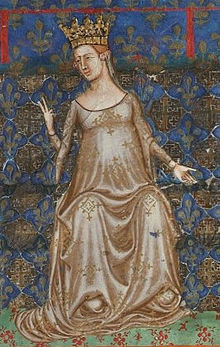Beatrix of Provence
Beatrix of Provence ( French Béatrice de Provence ) (* 1231 ; † September 23, 1267 ) was a Countess of Provence and Queen of Sicily .
Life
She was the youngest daughter of Count Raimund Berengar V of Provence and Beatrix of Savoy . Since her three older sisters had already been married and thus cared for while their father was alive, her father made Beatrix the universal heiress of the House of Provence. On January 31, 1246, she married Count Karl von Anjou , the youngest brother of her brother-in-law, King Louis IX. (Saint Louis) of France .
Beatrix accompanied her husband on the sixth crusade to Egypt. During the wintering of the Crusaders' army in Cyprus from 1248 to 1249, she gave birth to a son, as can be seen in the letter from her brother-in-law Robert von Artois to her mother-in-law Blanka of Castile . However, the child died soon after birth and was buried in the Dominican convent of Nicosia .
Charles of Anjou conquered the Kingdom of Sicily in 1266 and destroyed the Hohenstaufen (execution of Conradin on October 29, 1268). In 1282 he lost Sicily to the house of Aragón as a result of the popular uprising of the " Sicilian Vespers ". His rule was limited to the area called the Kingdom of Naples . The descendants of Beatrix and Karl ruled in Naples from 1285 to 1442, in Hungary from 1308 to 1382 and in Poland from 1370 to 1382. Karl von Anjou was taken over by his brother (and brother-in-law) Louis IX. militarily and from his brother-in-law Heinrich III. financially supported by England . The financial support for the actions of Charles of Anjou in Italy (on behalf of the Pope) by the English King Henry III. was also a reason for the opposition of the barons.
The brothers Beatrix of Savoy and uncle of the four sisters Peter II , Count of Savoy (1263-1268), Wilhelm , Bishop of Liège (1238-1239) and Thomas II. Count of Hainaut (1237-1244), Count of Piedmont (1247–1259), exercised great power in England between 1236 and 1258. Other brothers were Amadeus IV. , Count of Savoy (1232–1253) and Imperial Vicar in Italy (1241–1253) and Philip , Count of Savoy (1268–1285). It can be assumed that the Savoyards Heinrich III. persuaded to support the policies of the Pope and Charles of Anjou in Italy.
The weakness of Emperor Frederick II after his ostracism by the Pope in 1245 was evident in the events of succession in Provence in 1246 (in Austria also in 1246, in Thuringia in 1247). For the orphaned imperial fiefdom, the emperor would have had to nominate a suitable candidate for marriage for Beatrix, for which only his son Conrad IV came into question, which was not possible now. Instead, the marriage of Beatrix and Karl strengthened the French and weakened the Roman-German influence on the fortunes of Provence.
According to her last will, Beatrix wanted to be buried in Saint-Jean-de-Malte in Aix-en-Provence , the traditional burial place of the Counts of Provence. However, her husband ignored it and had her buried in the cathedral of Naples . Only after the Pope had urged him to respect her will, did he transfer her body to Aix in 1277.
progeny
The following children emerged from his marriage to Karl von Anjou:
- Ludwig (* / † 1248 in Nicosia)
- Blanche (around 1250 - January 10, 1269)
- ⚭ 1266 with Count Robert III. of Flanders († 1322)
-
Beatrix (* around 1252; † 1275)
- ⚭ 1273 with Philipp von Courtenay († 1283), titular emperor of Constantinople
- Charles II the Lame (* 1254 - 6 May 1309 in Naples), King of Naples
- Philipp (* 1256; † January 1, 1277 in Bari )
- Robert (around 1258; † 1265)
-
Isabella (* 1261; † 1304)
- ⚭ 1272 with King Ladislaus IV of Hungary († 1290)
literature
- Tanja Michalsky : Memoria and Representation. The tombs of the Anjou royal family in Italy (= publications of the Max Planck Institute for History. Vol. 157). Vandenhoeck & Ruprecht, Göttingen 2000, ISBN 3-525-35473-8
Web links
Individual evidence
| predecessor | Office | successor |
|---|---|---|
| Raimund Berengar V. |
Countess of Provence 1245–1267 |
Charles I of Anjou |
| personal data | |
|---|---|
| SURNAME | Beatrix of Provence |
| ALTERNATIVE NAMES | Beatrice de Provence |
| BRIEF DESCRIPTION | Queen of Sicily, Countess of Provence |
| DATE OF BIRTH | 1231 |
| DATE OF DEATH | September 23, 1267 |

